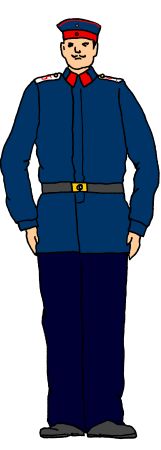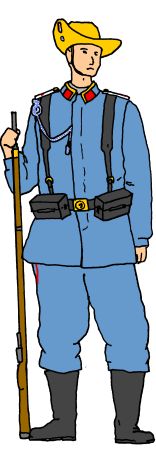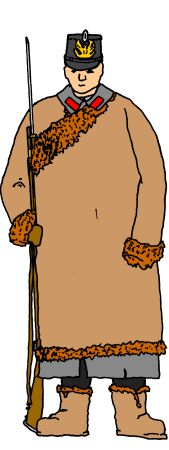|
East Asian Expeditionary Corps
1900-01
Ostasiatisches Expeditionskorps
Winter Uniforms
|
|
 |
 |
 |
 |
 |
|
Figure 1
Württemberg Infantry |
Figure 2
Prussian Artillery NCO |
Figure 3
Prussian Cavalry |
Figure 4
Bavarian Infantry NCO |
Figure 5
Prussian Jäger |
| |
Figure 1 is based on a photograph
of an Infantryman from the 2nd (Württemberg) Battalion of the 5th East
Asian Infantry Regiment in blue winter service uniform. This blue
uniform was also worn on home service. It consisted of a dark blue
(for most units) M1893 Litewka tunic with a stand and fall collar, no
visible pockets, a concealed front and gathered cuffs. The collar
patches were in arm-of service colour (red for infantry and cavalry,
black for artillery and pioneers). The shoulder straps were the same
as for the early khaki uniforms (white with regimental number in red for
infantry, red for cavalry, red with an embroidered yellow grenade for
artillery). The matching trousers were usually worn tucked into the
boots, but on this occasion are worn over them.
With the blue uniform a matching field cap could be worn as shown here.
As with field caps for the regular army it was peakless for other
ranks, peaked for NCOs and officers and had two cockades- a imperial
one in black/white/red above a state one (in this case black/red/black
for the Kingdom of Wurttemberg). The hatband and piping also depended
on arm of service- red for infantry and cavalry, black with red piping
for artillery and pioneers).
The only equipment worn by this figure is an other ranks black leather
belt. |
| |
Figure 2 is based on a photograph of an
NCO
of the East Asian Artillery Regiment. He also wears the blue M1893 Litewka tunic but with black collar patches for the artillery and NCOs
rank lace along the front and upper edge of the collar. The privately
made tunics for officers and senior NCOs often had higher collars and
pockets. In this case the tunic has a single left breast pocket and two
hip pockets all with concealed buttons. The shoulder straps
are red with a yellow flaming grenade for the artillery. His trousers are dark blue/black riding
breeches reinforced with leather on the inside leg.
This NCO also wears the traditional German army spiked helmet or
Pickelhaube. As well as the field cap and straw hat, Pickelhaubes
were worn on service in China, sometimes with a grey/green cover. As with the regular German army,
artillery had a ball instead of a spike as shown here (and was
therefore known as a Kugelhelm rather than a Pickelhaube).
The Bavarian artillery were the exception to this rule, they still
wore a spiked helmet. The helmet plates worn by the infantry of the
East Asian Expeditionary Corps were those of their home units and
states- Prussian eagle (with or without guard star depending on
their home unit's status), Bavarian coat of arms, Saxon star,
Württemberg coat of arms or Baden griffin. The cavalry, artillery
and other arms of service all wore Prussian eagle helmet plates with
the guard star emblazoned across the front as worn here. The cockades on either side of the chin strap bosses
would have been in imperial colours on the right hand side
(black/white/red) and state
colours on the left (in this case black/white/black for Prussia).
This NCO was photographed on his return to Germany and thus is wearing
his newly awarded China medal (see right) on his left breast.
|

China Medal
(See
Colonial Medals Details Page)
Damien Doppler Collection
|
| |
Figure 3 is based on a
photograph of a Cavalryman from
the East Asian Cavalry (Reiter) Regiment. He wears the straw hat with
imperial and state cockades, an M1893 cavalry
Litewka tunic (the cavalry Litwekas were grey rather than blue) with black riding breeches. His collar patches and
shoulder straps are in red for cavalry.
He wears a marksmanship award (see
Specialist Insignia Page) in twisted imperial coloured
(black/white/red) braid across his right breast (unusually it seems to
be attached to the upper rather then lower end of the shoulder strap).
He carries one of several varieties of bandolier issued to mounted
troops of the East Asian Expeditionary Corps.
The spiked helmets for the Reiter Regiment were dragoon style with
squared peaks and a Prussian Eagle with the Guard Star. |
| |
Figure 4 is based on a
photograph
of an NCO from the 2nd (Bavarian)
Battalion of the 4th East Asian Infantry Regiment. Several
points mark him out as Bavarian. Firstly the Bavarian state cockade
(white/blue/white) below the imperial one on the straw hat. Secondly
he wears a pale blue (as opposed to dark blue) M1893 Litewka unique to
Bavarian units (corresponding to their uniforms in the regular German
army of the time). Thirdly his marksman's award is in blue and white
Bavarian colours. Marksman's awards were issued in state colours for
the different German states. As the East Asian Expeditionary
Corps was an elite unit formed from the best volunteers from the whole
German army, the incidence of marksman's awards was disproportionately
high.
Aside from these differences he is dressed as any other Infantryman of
the East Asian Expeditionary Corps in the winter of 1900 with red
infantry collar patches and NCO (Unteroffizier) lace on the top
and front edges of the collar. |
| |
| Figure 5 is based on a
photograph of a Prussian Jäger from the East Asian Jäger Company on guard duty in Peking. He wears a
Jäger shako in place of the infantry's pickelhaube, with a
Prussian eagle as the helmet plate below an oval Prussian (white/black)
cockade. He wears a locally made animal skin coat over his army issue greatcoat and
uniform to ward off the fierce Chinese
Winter in a chilling foretaste of what the German army was to
experience on the Eastern front in two world wars to come. The collar
of his single breasted other ranks M1894 grey greatcoat with red patches can be
seen overlapping the locally made coat. Similarly he wears locally
made boots over his issue ones and dark blue/black trousers. Litewkas for the Jäger were in grey like the cavalry
ones but with dark green collar patches. |
| |
| In addition to this
already confusing array of uniforms worn by the Expeditionary Corps
many senior officers still wore the uniforms of their old regiments.
Field Marshall von Waldersee, the Expedition's commander often wore
his 13th Hanoverian Ulan Regiment uniform, while other high ranking
officers were photographed in China in the uniforms of Infantry,
Dragoon and Hussar Regiments. |
|
Main Sources-
"Uniformierung und Austrüstung der Ostasiatischen
Truppen des Deutschen Reiches 1900-1909" by Jürgen Kraus in
Zeitschrift für Heereskunde Issue
375
"Unsere Truppen in
Ostasien" - illustrated plates by
Moritz Ruhl
"Deutsches Ostasiatisches Expeditionskorps 1900-01"- illustrated plates by Eberhard Hettler
"Deutsche Expeditionstruppen und
Schutztruppen"- illustrated plates by Edgar Graf von Matuschka |
|